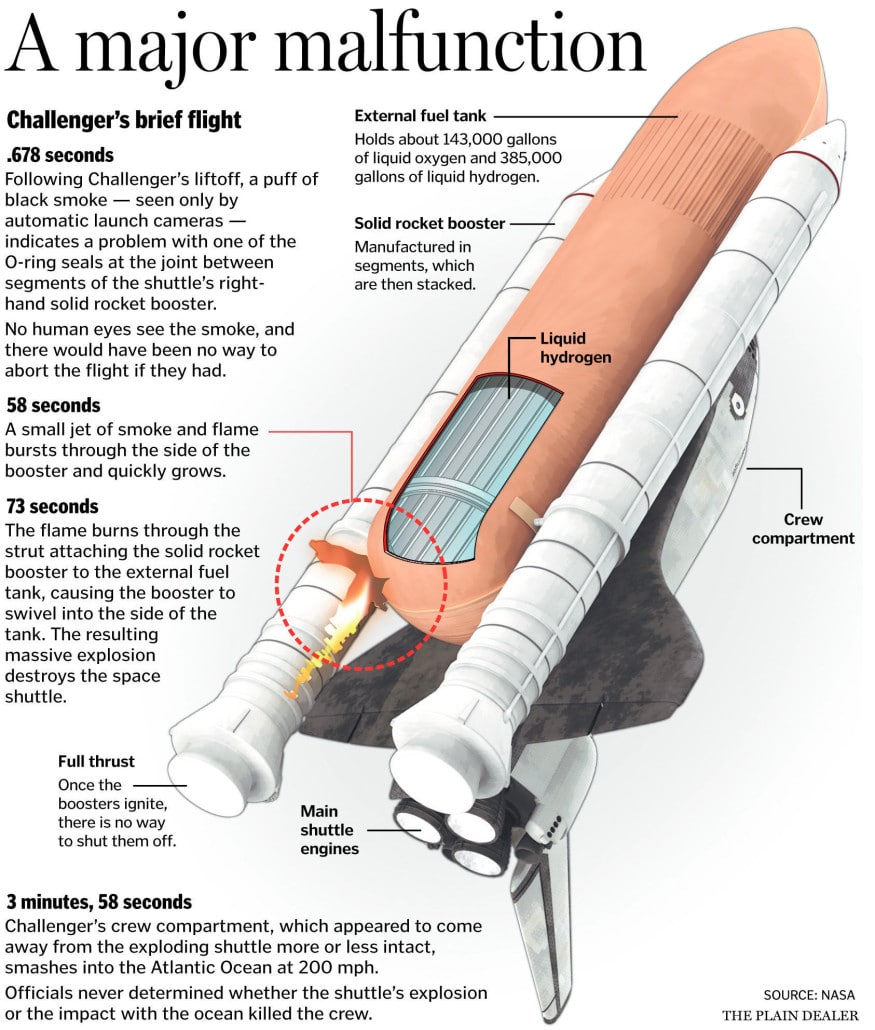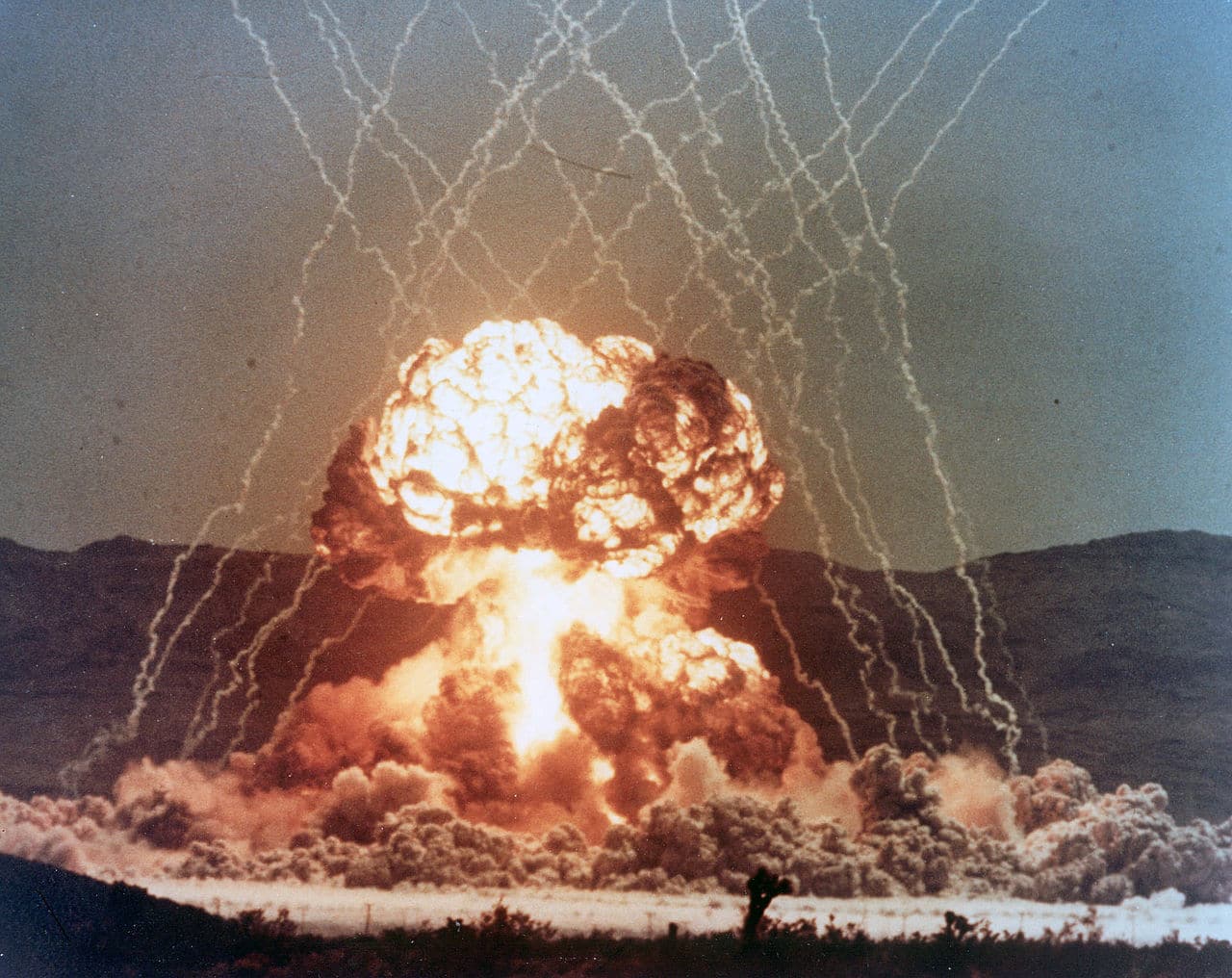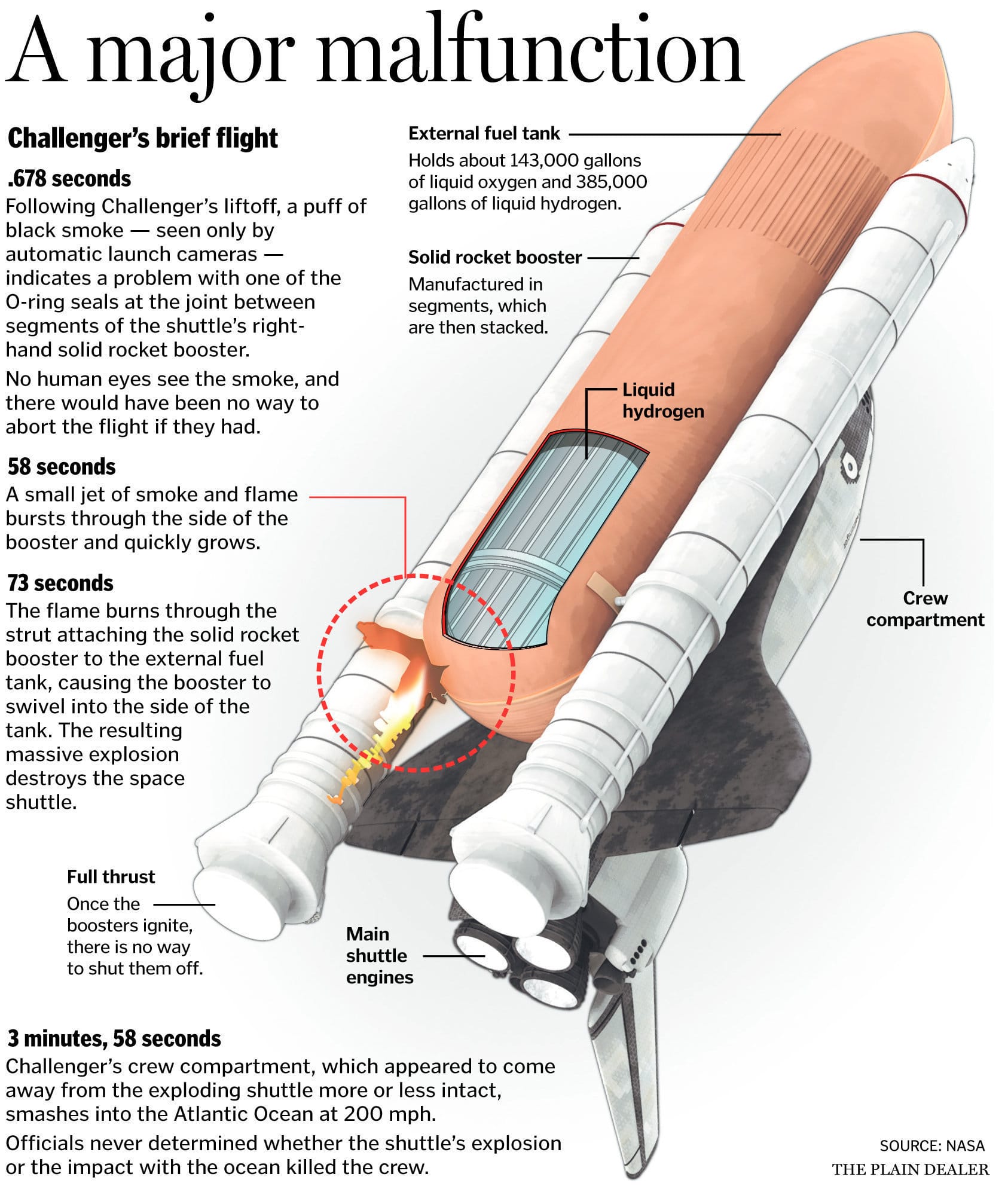
Today is the 30th anniversary of the failed STS-51-L mission of the Challenger. It was her tenth mission. All seven crew members were killed in the failure — this wasn’t quite our finest hour, as America and the world discovered during the Rogers Commission report, a huge part in thanks to the hard-ass stylings of Dr. Richard Feynman.
Commander Francis R. Scobee — Second spaceflight
Pilot Michael J. Smith — First spaceflight
Mission Specialist 1 Ellison S. Onizuka — Second spaceflight
Mission Specialist 2 Judith A. Resnik — Second spaceflight
Mission Specialist 3 Ronald E. McNair — Second spaceflight
Payload Specialist 1 Gregory B. Jarvis — First spaceflight
Payload Specialist 2 S. Christa McAuliffe — First spaceflight
Video of the incident — many of us reading this probably sat at a grade school library table and watched this happen. I remember I sure did. Mrs. Wilton was so upset, I will never forget that for some reason.
Here’s some pretty interesting video, this is NASA mission video of the Challenger launch and failure:
Some interesting facts that many people never knew about this mission:
- Challenger lasted 73 seconds off the pad that day.
- Four of the astronauts enabled their own secondary oxygen packs, which can only be done manually. This was discovered after the capsule was recovered; that means that they were not killed by the explosion. It is likely they were alive, but decidedly unconscious when they hit the water. If the explosion had not caused their deaths, NASA believes that the water impact would have.
- As part of the Rogers Commission, famed scientist and mathematical bad ass (and 1965 Nobel Prize winner in Theoretical Physics) Richard Feynman deduced that there was a failure of the rubber o-rings sealing the rocket booster motors; on the day that the Challenger exploded, aerospace/military/chemical engineering contractor Morton Thiokol had only certified the o-rings for 53 degrees Fahrenheit, and the launch was predicted to have the o-ring ambient temperature at 29 degrees Fahrenheit. The rubber o-ring seal on the solid rocket boosters literally were pinched and cold and didn’t bounce back like a normal piece of malleable rubber would. This was the overall cause of the failure. Dr. Feynman actually demonstrated this on television live in a glass of ice water and a c-clamp, funny enough. The scientific pwnage that took place during that press conference was actually pretty fantastic, because the NASA managers involved had been playing and hiding things during the investigation:
- The o-ring failure actually killed the Challenger crew twice in a way, as there was evidence between 0.678 seconds and 2.30 seconds on the mission clock that the o-rings had a few points of failure noticed in the re-observation of the video during investigation. Instantly though, these holes were sealed back up with aluminum oxides as the fuel burned — these oxides are of a very glassy, fragile nature, and in an almost fate-sealed string of events, the worst wind-shear NASA had ever experienced on a mission also happened that morning, slapping the SRBs around so hard that the oxides plugging those holes just became no more, allowing 5,000-degree gasses to escape at the seal point, melting the strut into the fuel tank, and destroying the vehicle.
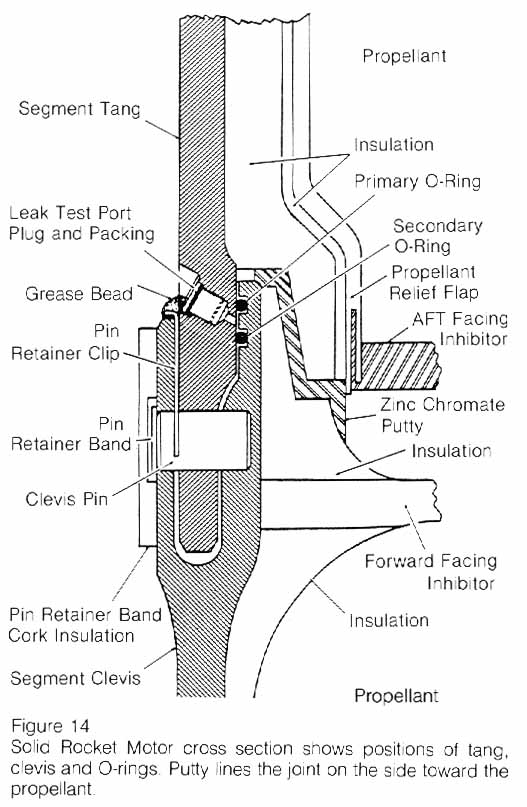
- You know how big that gap was in the rubber o-ring seal that caused the failure? 0.004 — four one thousandths of an inch. Essentially what happened was that the seal location was not a round shape, and since the air was so cold the night before and day of the launch that the rubber seals compressed and stayed that shape. NASA was counting on the seals to be springy, malleable, able to withstand the pressure.
If you’ve never read any of the Rogers Commission Report on the Challenger disaster and you are so inclined, I highly recommend it — the researcher/science nerd part of me totally digs on that stuff. Here, for example, is the Condition’s Cause Findings from the Commission, published here, at NASA — this particular page is Chapter 4 — Chapter 5 is even more scathing, rightfully so.
Chapter 4 – THE CAUSE OF THE ACCIDENT
The consensus of the Commission and participating investigative agencies is that the loss of the Space Shuttle Challenger was caused by a failure in the joint between the two lower segments of the right Solid Rocket Motor. The specific failure was the destruction of the seals that are intended to prevent hot gases from leaking through the joint during the propellant burn of the rocket motor. The evidence assembled by the Commission indicates that no other element of the Space Shuttle system contributed to this failure.
In arriving at this conclusion, the Commission reviewed in detail all available data, reports and records; directed and supervised numerous tests, analyses, and experiments by NASA, civilian contractors and various government agencies; and then developed specific scenarios and the range of most probable causative factors.
FINDINGS
1. A combustion gas leak through the right Solid Rocket Motor aft field joint initiated at or shortly after ignition eventually weakened and/or penetrated the External Tank initiating vehicle structural breakup and loss of the Space Shuttle Challenger during STS Mission 51-L.
2. The evidence shows that no other STS 51-L Shuttle element or the payload contributed to the causes of the right Solid Rocket Motor aft field joint combustion gas leak. Sabotage was not a factor.
3. Evidence examined in the review of Space Shuttle material, manufacturing, assembly, quality control, and processing on non-conformance reports found no flight hardware shipped to the launch
site that fell outside the limits of Shuttle design specifications.
4. Launch site activities, including assembly and preparation, from receipt of the flight hardware to launch were generally in accord with established procedures and were not considered a factor in the accident.
5. Launch site records show that the right Solid Rocket Motor segments were assembled using approved procedures. However, significant out-of-round conditions existed between the two segments joined at the right Solid Rocket Motor aft field joint (the joint that failed).
a. While the assembly conditions had the potential of generating debris or damage that could cause O-ring seal failure, these were not considered factors in this accident.
b. The diameters of the two Solid Rocket Motor segments had grown as a result of prior use.
c. The growth resulted in a condition at time of launch wherein the maximum gap between the tang and clevis in the region of the joint’s O-rings was no more than .008 inches and the average
gap would have been .004 inches.
d. With a tang-to-clevis gap of .004 inches, the O-ring in the joint would be compressed to the extent that it pressed against all three walls of the O-ring retaining channel.
e. The lack of roundness of the segments was such that the smallest tang-to-clevis clearance occurred at the initiation of the assembly operation at positions of 120 degrees and 300 degrees around the circumference of the aft field joint. It is uncertain if this tight condition and the resultant greater compression of the O-rings at these points persisted to the time of launch.
6. The ambient temperature at time of launch was 36 degrees Fahrenheit, or 15 degrees lower than the next coldest previous launch.
a. The temperature at the 300 degree position on the right aft field joint circumference was estimated to be 28 degrees plus or minus 5 degrees Fahrenheit. This was the coldest point on the joint.
b. Temperature on the opposite side of the right Solid Rocket Booster facing the sun was estimated to be about 50 degrees Fahrenheit.
7. Other joints on the left and right Solid Rocket Boosters experienced similar combinations of tang-to-clevis gap clearance and temperature. It is not known whether these joints experienced distress during the flight of 51-L.
8. Experimental evidence indicates that due to several effects associated with the Solid Rocket Booster’s ignition and combustion pressures and associated vehicle motions, the gap between the tang and the clevis will open as much as .017 and .029 inches at the secondary and primary O-rings, respectively.
a. This opening begins upon ignition, reaches its maximum rate of opening at about 200-300 milliseconds, and is essentially complete at 600 milliseconds when the Solid Rocket Booster reaches its
operating pressure.
b. The External Tank and right Solid Rocket Booster are connected by several struts, including one at 310 degrees near the aft field joint that failed. This strut’s effect on the joint dynamics is to enhance the opening of the gap between the tang and clevis by about 10-20 percent in the region of 300-320 degrees.
9. O-ring resiliency is directly related to its temperature.
a. A warm O-ring that has been compressed will return to its original shape much quicker than will a cold O-ring when compression is relieved. Thus, a warm O-ring will follow the opening of the
tang-to-clevis gap. A cold O-ring may not.
b. A compressed O-ring at 75 degrees Fahrenheit is five times more responsive in returning to its uncompressed shape than a cold O-ring at 30 degrees Fahrenheit.
c. As a result it is probable that the O-rings in the right solid booster aft field joint were not following the opening of the gap between the tang and cleavis at time of ignition.
10. Experiments indicate that the primary mechanism that actuates O-ring sealing is the application of gas pressure to the upstream (high-pressure) side of the O-ring as it sits in its groove or
channel.
a. For this pressure actuation to work most effectively, a space between the O-ring and its upstream channel wall should exist during pressurization.
b. A tang-to-clevis gap of .004 inches, as probably existed in the failed joint, would have initially compressed the O-ring to the degreethat no clearance existed between the O-ring and its upstream channel wall and the other two surfaces of the channel.
c. At the cold launch temperature experienced, the O-ring would be very slow in returning to its normal rounded shape. It would not follow the opening of the tang-to-clevis gap. It would remain in its compressed position in the O-ring channel and not provide a space between itself and the upstream channel wall. Thus, it is probable the O-ring would not be pressure actuated to seal the gap in time to preclude joint failure due to blow-by and erosion from hot combustion gases.
11. The sealing characteristics of the Solid Rocket Booster O-rings are enhanced by timely application of motor pressure.
a. Ideally, motor pressure should be applied to actuate the O-ring and seal the joint prior to significant opening of the tang-to-clevis gap (100 to 200 milliseconds after motor ignition).
b. Experimental evidence indicates that temperature, humidity and other variables in the putty compound used to seal the joint can delay pressure application to the joint by 500 milliseconds or more.
c. This delay in pressure could be a factor in initial joint failure.
12. Of 21 launches with ambient temperatures of 61 degrees Fahrenheit or greater, only four showed signs of O-ring thermal distress; i.e., erosion or blow-by and soot. Each of the launches below 61 degrees Fahrenheit resulted in one or more O-rings showing signs of thermal distress.
a. Of these improper joint sealing actions, one-half occurred in the aft field joints, 20 percent in the center field joints, and 30 percent in the upper field joints. The division between left and right Solid Rocket Boosters was roughly equal.
b. Each instance of thermal O-ring distress was accompanied by a leak path in the insulating putty. The leak path connects the rocket’s combustion chamber with the O-ring region of the tang and clevis. Joints that actuated without incident may also have had these leak paths.
13. There is a possibility that there was water in the clevis of the STS 51-L joints since water was found in the STS-9 joints during a destack operation after exposure to less rainfall than STS 51-L. At
time of launch, it was cold enough that water present in the joint would freeze. Tests show that ice in the joint can inhibit proper secondary seal performance.
14. A series of puffs of smoke were observed emanating from the 51-L aft field joint area of the right Solid Rocket Booster between 0.678 and 2.500 seconds after ignition of the Shuttle Solid Rocket Motors.
a. The puffs appeared at a frequency of about three puffs per second. This roughly matches the natural structural frequency of the solids at lift off and is reflected in slight cyclic changes of the tang-to-clevis gap opening.
b. The puffs were seen to be moving upward along the surface of the booster above the aft field joint.
c. The smoke was estimated to originate at a circumferential position of between 270 degrees and 315 degrees on the booster aft field joint, emerging from the top of the joint.
15. This smoke from the aft field joint at Shuttle lift off was the first sign of the failure of the Solid Rocket Booster O-ring seals on STS 51-L.
16. The leak was again clearly evident as a flame at approximately 58 seconds into the flight. It is possible that the leak was continuous but unobservable or non-existent in portions of the intervening
period. It is possible in either case that thrust vectoring and normal vehicle response to wind shear as well as planned maneuvers reinitiated or magnified the leakage from a degraded seal in the
period preceding the observed flames. The estimated position of the flame, centered at a point 307 degrees around the circumference of the aft field joint, was confirmed by the recovery of two fragments of the right Solid Rocket Booster.
a. A small leak could have been present that may have grown to breach the joint in flame at a time on the order of 58 to 60 seconds after lift off.
b. Alternatively, the O-ring gap could have been resealed by deposition of a fragile buildup of aluminum oxide and other combustion debris. This resealed section of the joint could have been disturbed by thrust vectoring, Space Shuttle motion and flight loads inducted by changing winds aloft.
c. The winds aloft caused control actions in the time interval of 32 seconds to 62 seconds into the flight that were typical of the largest values experienced on previous missions.
CONCLUSION
In view of the findings, the Commission concluded that the cause of the Challenger accident was the failure of the pressure seal in the aft field joint of the right Solid Rocket Booster. The failure was
due to a faulty design unacceptably sensitive to a number of factors. These factors were the effects of temperature, physical dimensions, the character of materials, the effects of reusability, processing and the reaction of the joint to dynamic loading.
(Source: The Presidential Commission on the Space Shuttle Challenger Accident Report, June 6, 1986 p.40, p.70-81)
Rest in peace, you seven steely-eyed missile people.
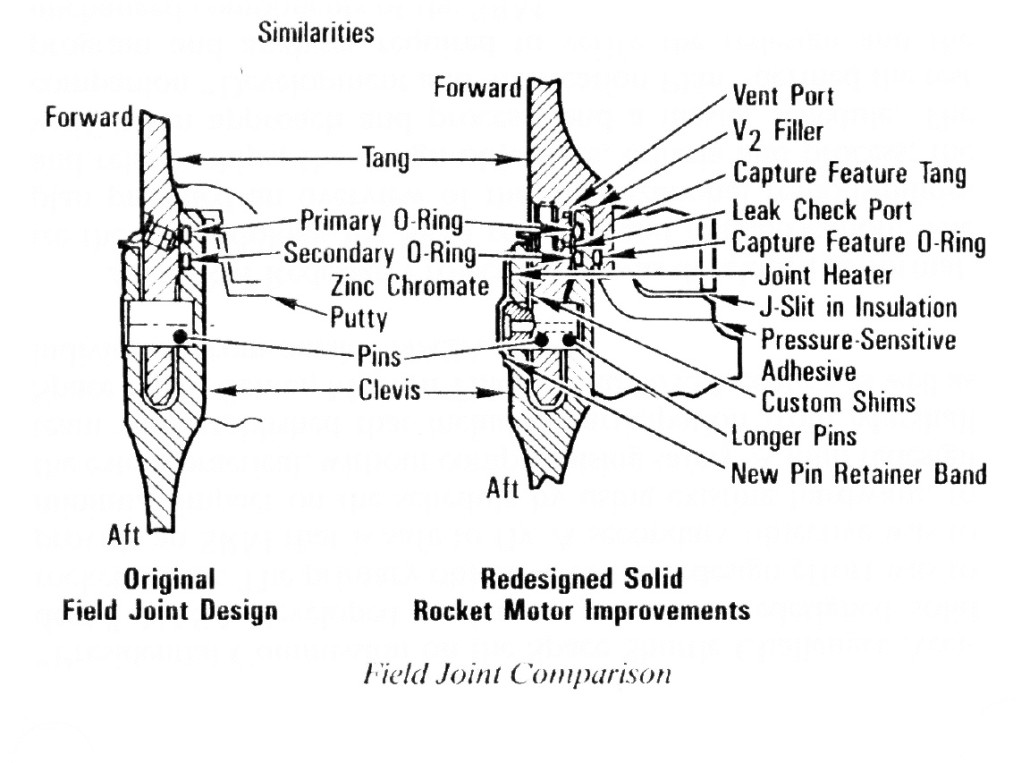
Link thanks:
http://www.nasa.gov/centers/langley/news/researchernews/rn_Colloquium1012.html
https://www.awesomestories.com/asset/view/Solid-Rocket-Motor-Cross-Section-with-O-Ring-Locations
http://www.spacesafetymagazine.com/space-disasters/challenger-disaster/
http://blog.cleveland.com/metro/2011/01/we_remember_the_challenger_shu.html
This link right here, a f*cking nerd’s wet dream:
http://datavirtualizer.com/critical-importance-of-data-visualization/
http://www.history.com/topics/challenger-disaster
http://www.engineering.com/Library/ArticlesPage/tabid/85/ArticleID/170/categoryId/7/The-Space-Shuttle-Challenger-Disaster.aspx

